It was noon when my wife, Judy, and I left the rental shop in Vancouver where we had picked up the 2011 Harley-Davidson we would be riding the next few days. The GPS on the Electra Glide Ultra Limited had been set to guide us out of town to Hope along British Columbia 7. From there we planned to double back along the Trans-Canada Highway, and then cruise up the Sea to Sky Highway to Whistler, where we were staying.
The GPS seemed determined, however, to get us onto the Trans-Canada, so we groped through suburban Vancouver on our own until we got out of town, after which we followed the Fraser River and BC 7 signs. Through farmland and up a narrowing valley, we took it easy while we grew accustomed to the unfamiliar bike. The big cruiser was a dream on the road, but a lot of weight to deal with in the stop-and-go we frequently encountered in the development along this stretch.
One thing was already abundantly clear: The mountains here are much, much steeper than those in Colorado, our home. And they drew closer and closer in as we neared Hope.
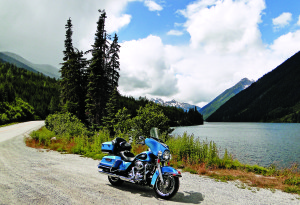
Hope was the filming location for First Blood, the first Rambo movie, and has a decent assortment of restaurants. It made a good stop for lunch and reassessment. Getting through Vancouver had been tedious, just as it had been in our rental car a couple days earlier. Heading back through that mess was not appealing, especially considering that Whistler was 169 miles away via that route. Pushing on around the mountains to reach Whistler from the other direction was only 187 miles. No doubling back for us.
We joined the two-lane Trans-Canada at Hope heading north, following the Fraser through a steep canyon of lush forest. At times the road ran high above the river. At other times it was close to water level, cutting through a series of tunnels when the canyon was just too narrow. While stopped due to an accident in a tunnel ahead, we had the opportunity to watch Native American fishermen working the river with nets, exercising their aboriginal rights and pulling in a lot of fish.
The road crossed the river and began to climb the canyon wall as the canyon itself grew steeper and narrower. Soon we were riding in a tight notch hacked into the side of the canyon, with the river hundreds of feet below us in a near-vertical drop. We reached the tightest point, Hell’s Gate, where the Fraser River pours more water through a 135-foot-wide gap than flows over Niagara Falls. An air tram will carry you down closer to the gushing water of the Fraser, one of Canada’s biggest rivers, where you can also see a fish ladder that helps salmon get upstream to spawn.
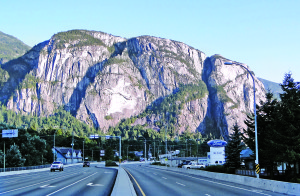
The canyon widened out, with the road descending as it continued up the Fraser River to Lytton. Here the Thompson River joins the Fraser, and the Trans-Canada follows the Thompson. We turned off on BC 12, which hugs the river north to Lillooet. The open valley at Lytton narrowed and the road ran along the broad shoulder high above the river, always with mountains towering above. On both sides, where the shoulders were wide enough, irrigated cropland shone a brilliant green. Elsewhere there were gray hillsides covered thinly with evergreens.
We ran along close to the river into the broad valley around Lillooet, and on our left we could see two massive rocks forming the gateway to the gorge we were to enter next. No stops in Lillooet today; due to our late start and delay at the tunnel it was getting toward dusk and we were eager to reach Whistler. We hurried our way along BC 99, the Duffey Lake Road, admiring the beauty but focusing more on eating up miles.
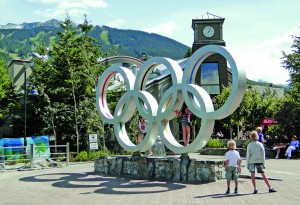
Some 60 miles later, the valley petered out on a ridge and we were cold, very cold. The tallest mountains around here are lower than our home in Denver, and this was August, but as the sun set the temperature plummeted. Foolish us, we had worn our summer riding gear.
A sign warning of 13-percent grades ahead got our attention, and riding down we quickly shed a lot of elevation. We reached Lillooet Lake, which fills the floor of the valley for miles on that side of the ridge, and quickly warmed up at the lower elevation. We then blasted through Pemberton and the short distance to Whistler.
With the exception of that steep decline to Lillooet Lake, we didn’t encounter mountain passes in British Columbia the way we do in Colorado. The mountains are so steep that roads simply don’t go up and over them; they go around them, following the canyons and valleys. The roads may run along the valley floor, or when the valley narrows into a canyon they are chiseled into the canyon wall.
The next morning we had only two choices: We could follow the road around to Vancouver, or we could head back toward Lillooet. We chose the latter. This time we wanted to actually enjoy the ride along Duffey Lake Road.
To Pemberton from Whistler the road carves its way up wide valleys below snowcapped peaks until it makes a hard left to climb that 13-percent grade. It’s at that point that BC 99 takes on the name of Duffey Lake Road, after the lake it passes in that valley.
The entire 60 miles to Lillooet the road descended through this valley. We rode down numerous steep declines which offered spectacular views and the road had curves that never ended. Duffey Lake was a deep blue body of water that perfectly set off the mountains behind it. On this clear, sunny day it demanded a stop.
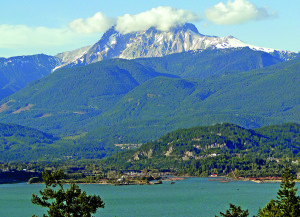
To here the road was in excellent condition with a number of modern bridges across the stream. From here on though, the road surface deteriorated and we took some hard bumps that jolted us roughly. The modern bridges gave way to old-style, but well-maintained, one-lane plank bridges.
Continuing down the valley, the walls converged and steepened into a gorge. The road scaled the side of the gorge, climbing and descending as the terrain dictated. Finally it came down to river level. We crossed the river and then a very steep climb carried us a little away from the river over a hillside that peered down into the gorge. Pull-outs made for great stopping places and offered more terrific views.
Finally over the top, the road took an equally extreme turn downward, with switchbacks aplenty. We reached the valley floor and followed the river between the massive stone cliffs and were delivered into Lillooet.
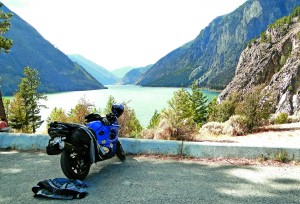
Cruising through Lillooet today you would never realize that at one time, thanks to the Cariboo Gold Rush of the 1850s and 1860s, this was the largest city north of San Francisco with 15,000 people. Perched on the high banks above the Fraser River, Lillooet today strives for the tourist dollar with the enticing catch phrase, “Guaranteed Rugged.” It is also home to what is reputed to be Canada’s only camel barn. During the gold rush, Lillooet resident John Callbreath brought 23 camels to use for mining. The experiment was a failure, but today the bridge over the Fraser is called the “Bridge of 23 Camels” and Lillooet includes a Camel Race as part of its annual Apricot Tsaqwem (Saskatoon berry) Festival in July.
From Lillooet we followed BC 99 on up the Fraser Canyon, riding on the shoulder above the river. The lush green vegetation of the Pacific Northwest gave way to sparse evergreens and a lot of brown, dry grasses. We wound for some miles high above the river and then abruptly took a sharp right turn away from it, climbing steeply over a saddle, much as we had done at Lillooet Lake though not as extreme. Just as before, we dropped down on the other side into a valley with the road descending steadily past a series of lakes.
BC 99 finally terminated as it spilled out into a broad farming valley and connected with the Cariboo Highway. A right turn took us to Cache Creek, where the Trans-Canada Highway comes up from Lytton. Our choices were to ride to Lytton and retrace our steps to Lillooet and Whistler, or turn back to Lillooet now. We turned back. Once again it was late in the day by the time we reached Whistler.
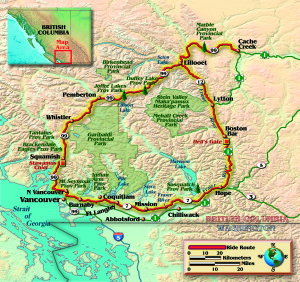
We had saved the best for last. The stretch of road called the Sea to Sky Highway runs from Vancouver to Pemberton, officially ending in Pemberton because that used to be where the pavement ended. That would be our route to return the Harley.
We wound our way down a series of valleys to Squamish, where the road reaches Howe Sound. Straight ahead of us coming into Squamish was the Stawamus Chief monolith, a granite dome (think Yosemite) rearing 2,297 feet above the town. We curved around the base of the monolith and rode parallel to the east shore of Howe Sound. Ahead of us and on both sides there were snow-covered mountains and the road itself was, like so many others, cut into the sheer rock face.
Formerly referred to by locals as the “Ski to Die” highway, the road was known for skiers going off the sides in bad weather as they made the run between Vancouver and Whistler. That changed in preparation for the 2010 Winter Olympics, which was centered in Vancouver, but for which Whistler provided the skiing venue.
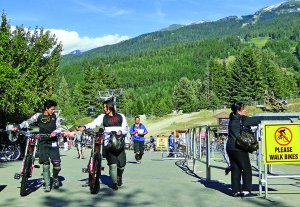
Now the road is largely a four-lane divided highway with center barriers and guardrails that make the trip much safer in winter. Motorcyclists might say the “improvements” downgraded an incredibly spectacular motorcycle road to merely a “terrific” ride, but then, unlike the skiers, we don’t have to contend with ice and snow in the summer when we’re using the road. In the meantime, the view over the Sound and the mountains beyond repeatedly made us catch our breaths. We had had no idea we would encounter this kind of incredible beauty.
Soon the name of the road started taking on a whole other meaning. With the Sound 1,000 feet below us on our right, and mountain peaks 3,000 to 4,000 feet above us on our left, these hillsides climb directly from the sea to the sky.
All too soon we reached Vancouver and crossed the Lion’s Gate Bridge, coming into the city through Vancouver’s jewel of greenery—1,000-acre Stanley Park. Here the GPS, preset to guide us home, proved a blessing. And our ride in this land of stupendous beauty was over.
(This article Where the Mountains Meet the Sea was published in the August 2012 issue of Rider.)

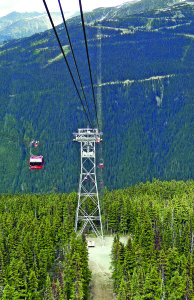
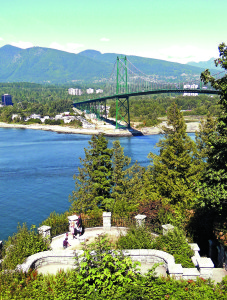
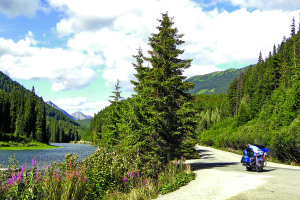
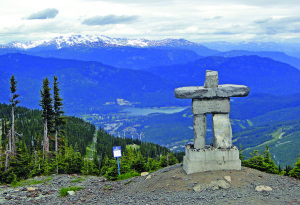







I am not Canadian but have ridden in Whistler and the Fraser River Valley a coule of times.